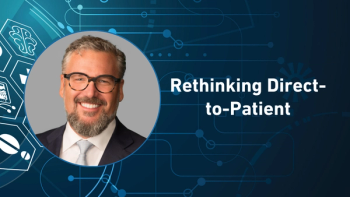
- Pharmaceutical Commerce - November/December 2014
A conversation with Homi Kapadia, Deloitte Life Sciences
Deloitte provides consulting, audit, enterprise risk, tax and financial advisory services to industries and governments around the world. Of its global employment of more than 200,000, 57,000 work for the US entities of Deloitte, and within that there are 4,000 professionals dedicated to the Life Sciences Practice.
Homi Kapadia was appointed head of the Life Sciences Practice last June. He sat down with Pharmaceutical Commerce this summer to talk about trends in life sciences, new initiatives in Deloitte and his evolving role. Here’s what he had to say.
1. Early in your career, you made the choice to join Deloitte, and you’ve been there ever since. Let’s hear about your early experience with Deloitte and Life Sciences, and the path you’ve been on since.
I was born and grew up in Bombay (now called Mumbai) in India to typical middle class urban parents. My father was an avid amateur athlete who excelled at table tennis and a variety of track and field events. Throughout my childhood I recall being awed by the large collection of trophies in our living room that he had won at national and regional sporting events. But while he was very competitive in sports, overall he was a mild mannered person with a strong moral compass, and this balanced approach has had a lasting impression on what I do today.
My parents saw education as “the great liberator” and strongly encouraged all my academic pursuits. I have always been analytically inclined, so after my undergraduate degree from the Indian Institute of Technology in Mumbai, I completed a Masters degree in computer science from UCLA. I then worked seven years in the industry in supply chain and information technology management roles before earning my MBA from UCLA.
I joined Deloitte 29 years ago, when it was a fraction of the scale we are today. My focus on life sciences began 13 years ago advising market-leading companies on their strategy, operations, enterprise applications and supply chain management. Soon after I was named a principal with Deloitte Consulting LLP, I received key leadership opportunities and participated in the growth of several of Deloitte’s business areas. And I have had the privilege of serving on the Board of Directors of Deloitte LLP as well as on the Deloitte Consulting Executive Committee. I was appointed to my current role as Vice Chairman and National Life Sciences Leader for Deloitte LLP in June 2014, a practice that encompasses clients in the pharmaceutical, biotechnology, medical technology, generics and federal health sectors.
So over the years, I have worked to hone the right blend of skills and experiences to position Deloitte as a trusted advisor as the industry responds to a new environment shaped by reform and market forces.
2. Congratulations on your appointment as Life Sciences Practice Leader. Help us put that practice in the context of Deloitte overall, and its relationship to Deloitte Touche Tohmatsu Ltd. (DTTL), the global member services company.
Thank you. I feel honored to take on this role in today’s environment, given the monumental transformations underway in the industry. Life sciences companies are truly global, and Deloitte is structured in like fashion, with more than 200,000 employees in 150 countries as part of Deloitte Touche Tohmatsu, one of the world’s largest professional services organizations. I lead the life sciences practice for the US member firm of Deloitte Touche Tohmatsu, which is known as Deloitte LLP. Our practice has about 4,000 professionals serving 13 of the 15 largest pharmaceutical manufacturers, 9 of the 10 largest medical device manufacturers and 6 of the 10 largest biotechnology companies. We work closely with our life sciences colleagues in other countries to seamlessly deliver services to our clients. As such, we are well-positioned to impact the life sciences industry, to help it navigate through its crossroads to a new era marked by personalized medicines, population health, additive 3-D printing, value-based care and other innovations.
But back to my role, let me note that Deloitte’s culture is one of teamwork and collaboration. So, while I serve as the National Sector Leader for Deloitte LLP’s Life Sciences Practice, I work closely with the life sciences leaders of each of our five businesses and other partners, principals, and directors across the country in formulating and driving our strategy.


3. You mentioned Deloitte’s five businesses. Deloitte’s standard characterization of what it does is “consulting, audit, advisory, tax and financial advisory services.” Is the Deloitte Life Sciences Practice evenly split among these businesses for life sciences companies? In today’s US healthcare environment, are they all equally sought for by clients?
All of Deloitte’s five businesses—Consulting, Audit, Enterprise Risk, Tax and Financial Advisory Services—provide essential services in the marketplace, services that companies may need in order to succeed from a competitive and regulatory perspective.
I do not think the question is which of these businesses are predominate, as they often come together on behalf of our clients’ needs. Take mergers and acquisitions, for example. When an enterprise looks to identify, engage and consummate a merger, it triggers an avalanche of questions related to valuation, strategy, financial reporting, tax structure, information technology, organizational structure, employee incentives, regulatory risk and others. So this one event, a merger or a divestiture, can spark a range of needs that can fall under our consulting, audit, enterprise risk, tax and financial advisory businesses.
M&A is at the top of the list for many organizations given the convergence underway throughout healthcare. Companies are searching for the right scale in today’s competitive environment, whether narrowing on a core set of capabilities or therapeutic areas, or building out scale by acquiring and managing a large portfolio of businesses across a range of therapeutic areas. Each approach is resulting in an unprecedented level of deal making in the form of mergers, acquisitions, joint ventures, divestitures and licensing agreements. We have a more unique ability to bring end-to-end breadth to an event like M&A, from strategy through implementation, planning and execution.
Another key area is regarding R&D productivity. A recent Deloitte and Thomson Reuters study of 12 large global life sciences companies found that their expected return on late stage pipeline projects has declined across four years, to 4.8 percent in 2013 from 10.5 percent in 2010. Along with that, the cost to develop and launch a new medicine has increased 18 percent, to $1.3 billion. So there is a need to reverse this trend or at least mitigate it, and Deloitte provides services that help companies increase the efficiency of R&D and maximize the commercial value of these investments.


4. In the tax and financial advisory area, I would assume that one of the hottest topics is the industry’s current fascination with mergers between US and non-US companies and the potential for “tax inversion.” What’s your view on the value of this action, and the business value of the mergers driven by such tax considerations?
Blanket statements are tricky because the value of conducting such transactions is deeply tied to a company’s particular circumstance, not just regarding its cost structure but also its strategy, footprint, culture and what it stands for in the marketplace.
Having said that, I think it’s premature to assume that the tax inversion deals that have made headlines are necessarily a harbinger to a big wave of additional deals. As we’ve seen recently, the administration is making it even less attractive and unpopular. I’m not suggesting we won’t see more interest. But I also think that companies will primarily drive their M&A decisions based on priorities aligned with their strategy. Another factor is governance. In some cases, companies may weigh the cost benefit of transferring their country of domicile against any requirements that cause executives to fly overseas or across borders to vote or make important decisions. So I think there could be factors coming into the equation that may cause companies to look at these opportunities from a broader perspective than just tax savings.

5. Let’s assume, as most people do, that Obamacare is now a done deal and the life sciences industry is confronting a changed healthcare consumer market. What is Deloitte advising its clients on how best to address the changed market?
One common theme is consumerism: We not only have more consumers coming into the health system via the exchanges and Medicaid expansion, but consumers who may have to take more responsibility for managing their health. This combination may cause health companies to fundamentally change around customer centricity—more consumers with more engagement requires more customer-centric business models. One of the broader implications here is the acceleration of remote health, of mobile health and telemedicine. In addition to more transparency around cost and quality, consumers are demanding more immediate access to their health records and activities.
Another impact is convergence, a blurring of the lines between the health sectors. We are seeing different sectors come together to coordinate patient-centered care, including
providers developing alliances with payers or establishing their own health plans. They may also form hubs around data, because in looking to lower costs and improve outcomes, providers have the patient data that plans need, and plans have the claims data that providers need. I also think an interesting trend playing out is how health insurers are looking to act more like a big box retailer. With the sudden influx of an individual market, plans may have to think like a retailer—how do I engage individuals, giving them the tools they need to be savvy shoppers? This will be interesting to watch as we go through Round 2 of Open Enrollment.


6. Health outcomes is one of the areas given new emphasis by the Affordable Care Act, and Deloitte has made a major internal investment in this with the opening of ConvergeHEALTH. Tell us about that initiative, and what your expectations are for how it will benefit life sciences companies.
All health sectors seem to be shifting from volume to value, but they can get hamstrung around an inability to characterize, measure and reward value based on real world evidence. In many cases the right data, informatics tools, collaborative models and incentives have not been there.
We are working to fill this gap with a venture called ConvergeHEALTH by Deloitte. ConvergeHEALTH is a major move into the health insights space, an effort to help the health system transform around big data to answer the “hard questions” associated with value based, personalized healthcare—what works, for whom, why, in what context and at what cost. To put it in perspective, it’s a $150-plus million investment by Deloitte, which would make it one of the best funded health analytic start-ups in the country if it were stand-alone.
The heart of ConvergeHEALTH is the active collaboration by different health organizations around data, research and outcomes—the convergence concept we discussed earlier. It’s a move toward the “learning health care system” that the Institute of Medicine promotes as the path toward a true transformation of the health system around quality and costs.
Accordingly, ConvergeHEALTH is developing new big data and analytics platforms and a consortium of organizations to work together on their biggest questions. Presently, the collaboration involves five marquee organizations: Deloitte, Intermountain Healthcare, Moffitt Cancer Center’s M2Gen, the Regenstrief Institute and the Northern New England Accountable Care Collaborative. All of these organizations are leaders in their own right in using data to understand health and disease. But together we can work to break down barriers in advancing analytical solutions that help manage population health, understand outcomes and quality, and support the shift to personalized medicine.
A great example is the three year collaboration we announced with Forest Laboratories (now part of Actavis Pharmaceuticals) in April in conjunction with Intermountain Healthcare. This effort is leveraging ConvergeHEALTH’s OutcomesMiner analytics solution to provide near real time insights from real world evidence and research with Intermountain to better understand patient outcomes and success factors in healthcare.
The net for a life sciences company is that it can generate not just data but insights around data, “analytics applied,” that can lead the industry to developing the right personalized medicine for the right patient populations at the right time.


7. Many pharma companies—generic and branded, US and non-US—are under severe burdens for regulatory compliance these days; while some maintain that this is actually a heightened focus by FDA, others say it points to an eroding internal ability to meet quality standards by manufacturers. What’s Deloitte’s view, and how are you helping companies maintain regulatory compliance?
In the last decade, the regulatory environment seems to have become less of an afterthought and more of a prevailing wind impacting a company’s direction. It seems to get more attention now at the executive and board levels than at any time I’ve seen in my time with the industry. Compounding the challenge is that manufacturers are retooling around the small-batch versus large batch approach and expanding their supply chains, which introduces more steps and risks into the manufacturing process as well as risks with vendors, contract manufacturers and distributors.
Greater harmony could be achieved in the regulatory environment if companies take an active role in proposed rule changes via public forums and other outlets by the federal government. There is also upside potential for companies to realize compliance efficiencies and improved product quality by investing in technologies that take the manual work out of the process. In today’s era of smart phones, many life sciences companies still rely on labor-intensive machinations in complying with regulation. This has created a conflict between personal day-to-day activities where people can do their banking and shopping on their smart phones and tablets, but are unable to view SOPs or interface directly with enterprise systems unless they are tied to their workstation. This conflict and its impact may increase pursuant to the accelerating rate of change and innovation available to an industry that has historically had to be a slow adopter given its regulatory environment.


8. The steady and rapid growth of specialty pharmaceuticals is changing how pharma companies interact with payers, providers and patients. Relatively high drug prices are one obvious issue, but beyond that, Deloitte is on record saying that pharma companies need closer relationships with patients to succeed. What’s your view on how to accomplish that?
Our perspective is that the industry is working to better demonstrate and communicate drug prices with respect to their true value. In other words, considering the overall health outcome achieved in light of the cost to produce that outcome and the role that the medication played. That value should be compared to the next best alternative inclusive of effectiveness rates, side effects, tolerability and beyond-the-pill services, such as programs to support better adherence. So while the price of a new treatment may appear high, if it is curative and replaces a treatment that is taken over a longer period with many doses and modest effectiveness, then the value is seen in a new light.
Additionally, pharmaceutical companies are working diligently to understand the needs of patients and families in order to support improved overall health outcomes by investing in “beyond the pill” services, which are largely provided at low to no cost.
Lastly, R&D innovation is expected to produce medicine for special diseases such as oncology, multiple sclerosis and rare diseases at an increased rate over the coming years. Given special requirements for storage and administration, as well as the higher costs for these medicines, we expect the demand for specialty pharmaceutical products to increase. Life sciences companies may be able to compete or offer some of those same patient services (which could reduce costs) if they are able to innovate around the distribution channel.


9. You were born and started your university education in India. On a personal level, do you keep business ties to the Indian pharmaceutical community, which is such an important part of global pharmaceutical production? Beyond that, what personal interests in healthcare complement your business interest?
While I was born and started my education in India, today my view is worldwide. I have traveled across the globe to meet with our life sciences clients and our Deloitte engagement teams. Deloitte serves Indian pharmaceutical companies both in India as well as in other countries. They are certainly an important part of providing healthcare products and solutions across many parts of the world, and Deloitte’s global network of industry practitioners supports their growth and innovation needs.
The innovation of our clients to solve critical diseases, the collaboration across large segments of our economy to make this a reality, and the measurable results achieved over the past century in taming many life-threatening diseases and conditions is truly remarkable. Life sciences companies often don’t get full credit for this and their significant intellectual property donations in third world countries.
I can speak for Deloitte’s entire life sciences practice when I say that we feel very privileged to be serving clients in an industry that is having such a significant impact on the health and wellness of billions across the globe.
Articles in this issue
about 11 years ago
The Context Renaissance in Pharmaabout 11 years ago
Cold Chain Forum showcases new products, servicesabout 11 years ago
Omnicare Specialty expands its offices; scores another clientabout 11 years ago
IMS Health's top 10 'harbingers of change' in pharmaceutical businessabout 11 years ago
Diplomat Pharmacy has a successful IPO, garnering $173 millionNewsletter
Stay ahead in the life sciences industry with Pharmaceutical Commerce, the latest news, trends, and strategies in drug distribution, commercialization, and market access.




